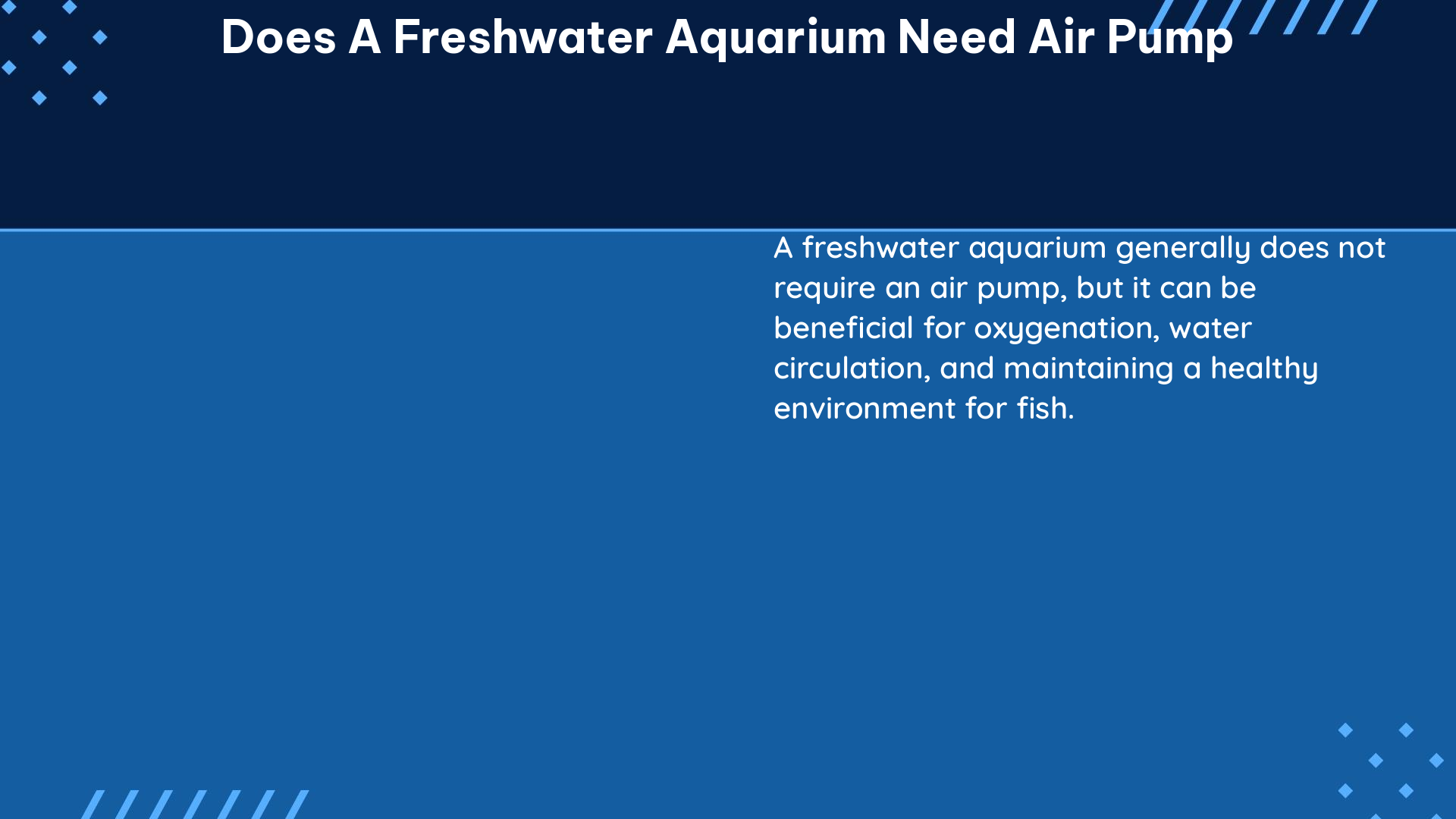A freshwater aquarium can maintain adequate oxygen levels for fish and other aquatic life without necessarily requiring an air pump. Oxygen enters the water and carbon dioxide is released through surface agitation, which can be achieved through various means. However, there are specific scenarios where an air pump may be beneficial or even necessary.
Understanding Oxygen Levels in Freshwater Aquariums
Dissolved oxygen (DO) is a critical parameter for the health and well-being of aquatic organisms in a freshwater aquarium. Ideally, the DO levels should be maintained between 5 and 7 parts per million (ppm) for optimal fish life. Levels below 2 ppm are considered dangerous and require immediate aeration.
The amount of dissolved oxygen in water is influenced by several factors, including:
- Water Temperature: Warmer water holds less dissolved oxygen than cooler water. As the temperature increases, the solubility of oxygen decreases.
- Water Movement: Increased surface agitation and water circulation promote gas exchange, allowing more oxygen to dissolve in the water.
- Plant Photosynthesis: Aquatic plants release oxygen during the day through photosynthesis, contributing to higher DO levels.
- Fish and Animal Respiration: Fish and other aquatic organisms consume oxygen and release carbon dioxide, which can lower DO levels.
- Organic Matter Decomposition: The breakdown of organic matter by bacteria and other microorganisms can deplete dissolved oxygen.
Scenarios Where an Air Pump May Be Beneficial

While a freshwater aquarium does not always require an air pump, there are certain situations where an air pump can be beneficial or even necessary:
- Medication Presence: When using medications in the aquarium, an air pump can help increase surface agitation and promote gas exchange, which can be important for maintaining adequate oxygen levels.
- Heavily Planted Tanks with Lights Off: In heavily planted aquariums, plants consume oxygen during the night when photosynthesis is not occurring. An air pump can help replenish the oxygen levels during these periods.
- High Temperatures or Overstocking: Elevated water temperatures or overstocking the aquarium with fish can lead to increased oxygen consumption and decreased oxygen solubility. An air pump can help maintain sufficient DO levels in these scenarios.
- Stagnant Water Conditions: If the aquarium has limited water movement or surface agitation, an air pump can help create the necessary water circulation and gas exchange.
- Sensitive Fish Species: Some fish species, such as bettas, gouramis, and certain catfish, may require higher oxygen levels than others. An air pump can be beneficial in maintaining the appropriate DO levels for these sensitive species.
Measuring Dissolved Oxygen Levels
To determine whether an air pump is necessary for a specific freshwater aquarium setup, it is recommended to measure the dissolved oxygen levels using a dissolved oxygen meter. This tool can provide accurate readings of the DO concentration in the water, allowing you to identify any potential oxygen deficiencies and take appropriate actions.
When measuring DO levels, consider the following guidelines:
- Ideal DO range: 5-7 ppm
- Dangerous levels: Below 2 ppm
- Measurement location: Take readings at different depths and locations within the aquarium to get a comprehensive understanding of the oxygen distribution.
- Timing: Measure DO levels at different times of the day, as levels can fluctuate due to factors like plant photosynthesis and fish respiration.
Factors Affecting Air Pump Effectiveness
While an air pump can be a valuable tool in maintaining adequate oxygen levels, its effectiveness may depend on various factors, including:
- Aquarium Size: Larger aquariums may require more powerful air pumps to achieve the desired level of surface agitation and gas exchange.
- Aquarium Depth: Deeper aquariums may require additional measures, such as multiple air stones or a more powerful air pump, to ensure sufficient oxygen distribution throughout the water column.
- Aquarium Stocking Density: Heavily stocked aquariums with a high biomass of fish and other aquatic organisms will have a higher oxygen demand, potentially requiring a more robust aeration system.
- Aquarium Filtration: The type and efficiency of the aquarium’s filtration system can also impact the need for an air pump. Well-designed filtration that creates surface agitation may reduce the necessity for a dedicated air pump.
- Aquarium Substrate: The type of substrate used in the aquarium can affect water movement and gas exchange. Substrates that promote water circulation, such as gravel or sand, may reduce the need for an air pump.
Conclusion
In summary, a freshwater aquarium does not always require an air pump to maintain adequate oxygen levels for fish and other aquatic life. Oxygen can be introduced through surface agitation, water movement, and other means. However, there are specific scenarios where an air pump can be beneficial or even necessary, such as when using medications, in heavily planted tanks, or in high-temperature or overstocked conditions.
To determine the need for an air pump in your freshwater aquarium, it is recommended to measure the dissolved oxygen levels using a DO meter. This will help you identify any potential oxygen deficiencies and take the appropriate actions to ensure the health and well-being of your aquatic inhabitants.
Remember, the effectiveness of an air pump can be influenced by various factors, including aquarium size, depth, stocking density, filtration, and substrate. By understanding these factors and monitoring the dissolved oxygen levels, you can make an informed decision on whether an air pump is necessary for your specific freshwater aquarium setup.
References:
– Reddit Discussion on Air Pumps in Aquariums
– What is an Aquarium Air Pump and Is It Necessary?
– Do I Need an Air Pump?
